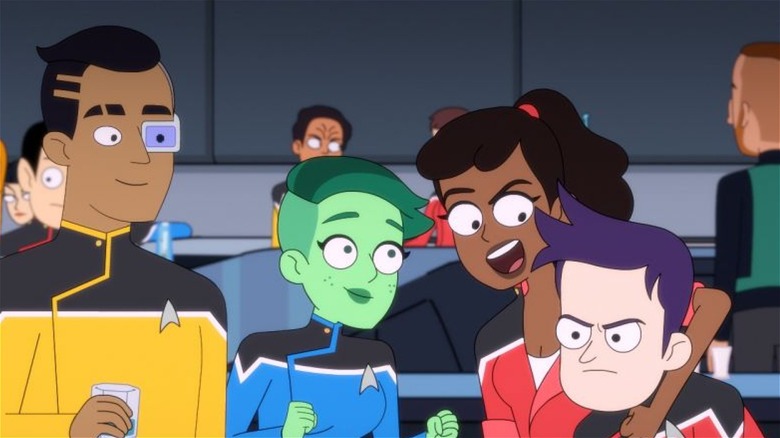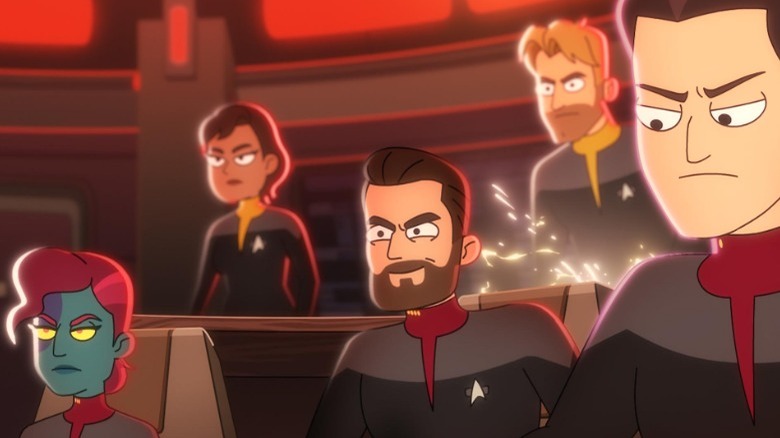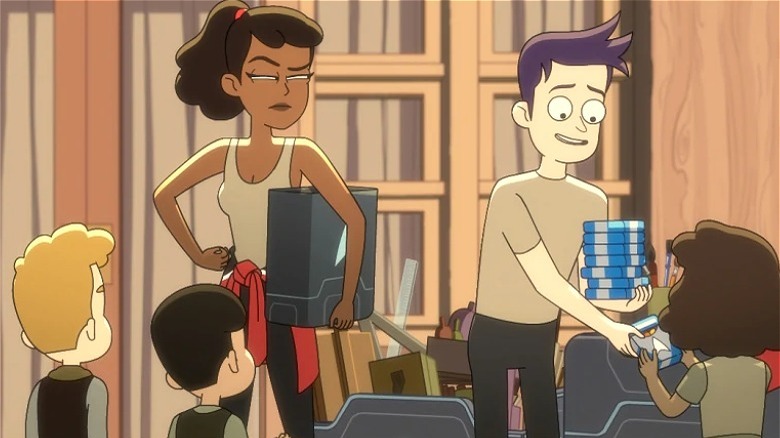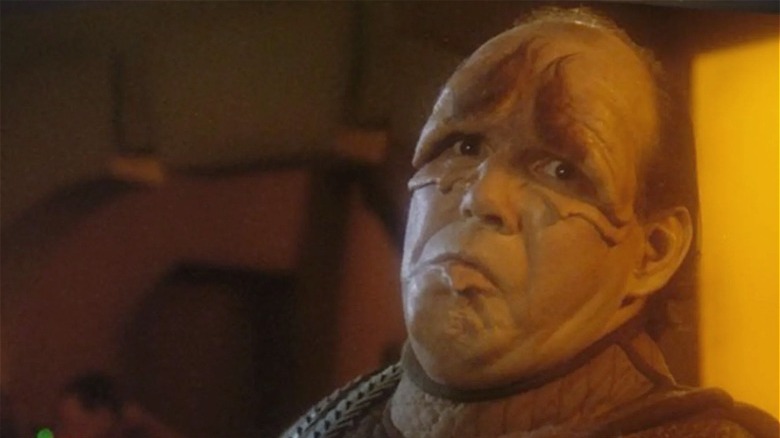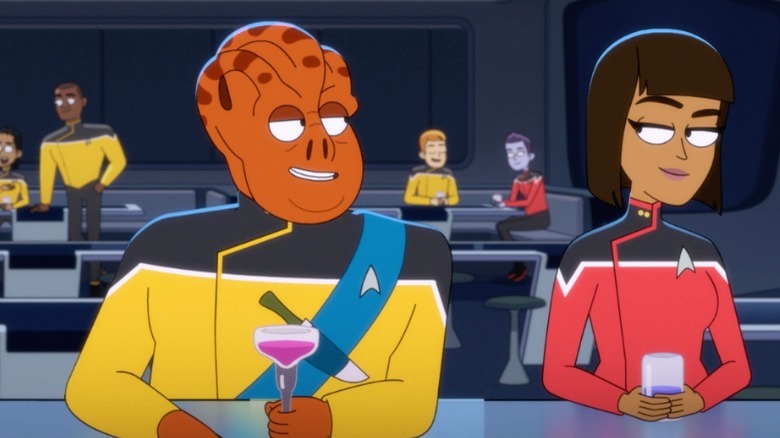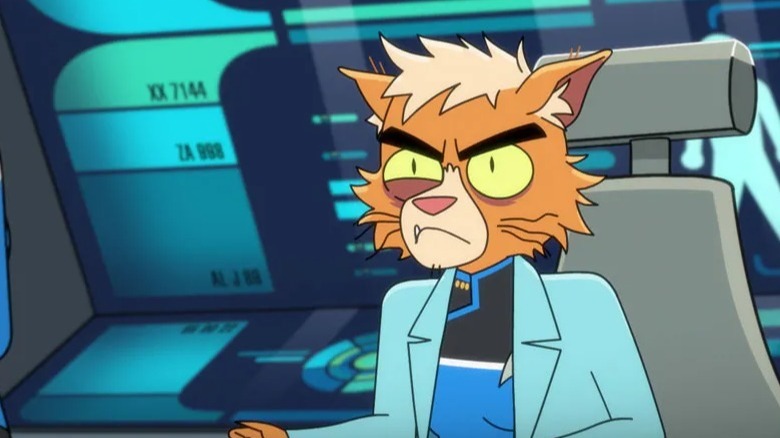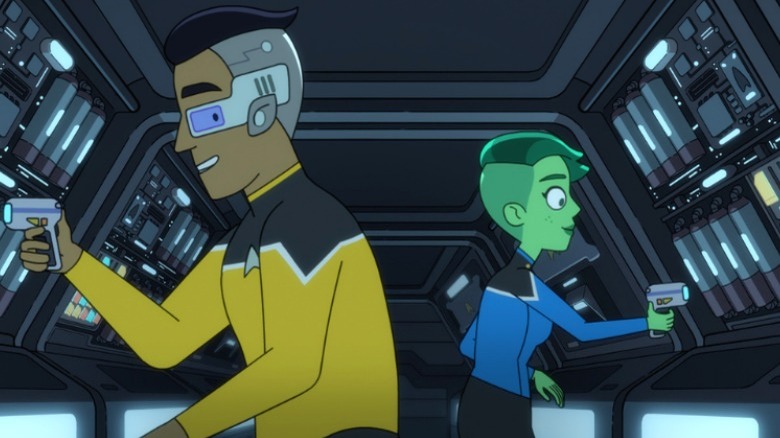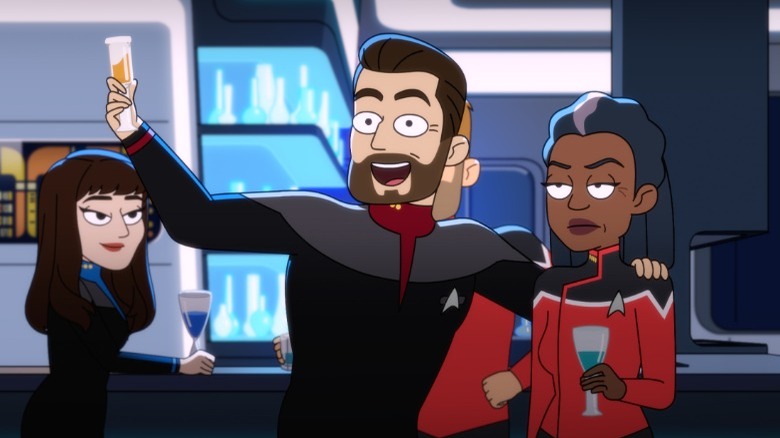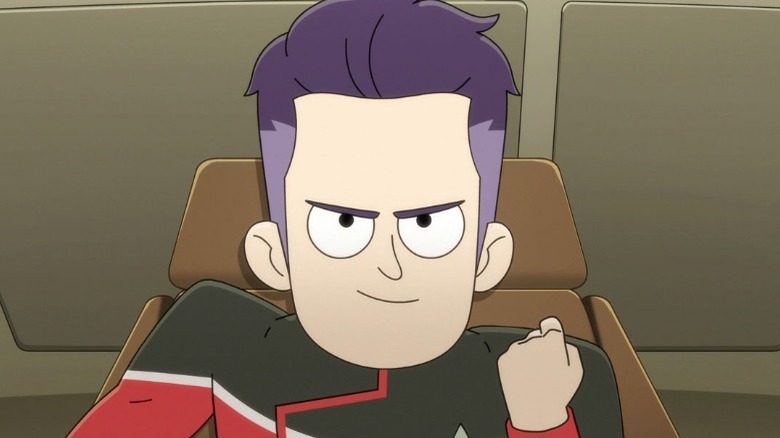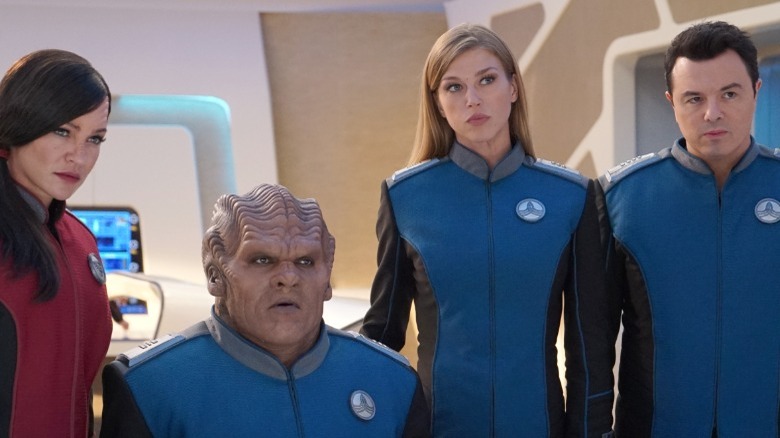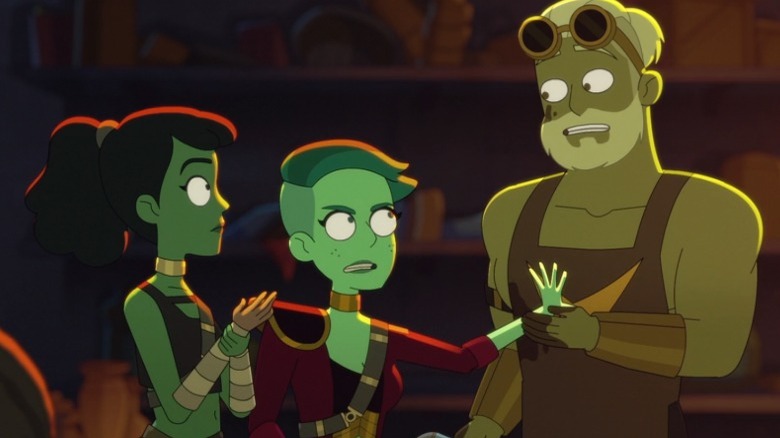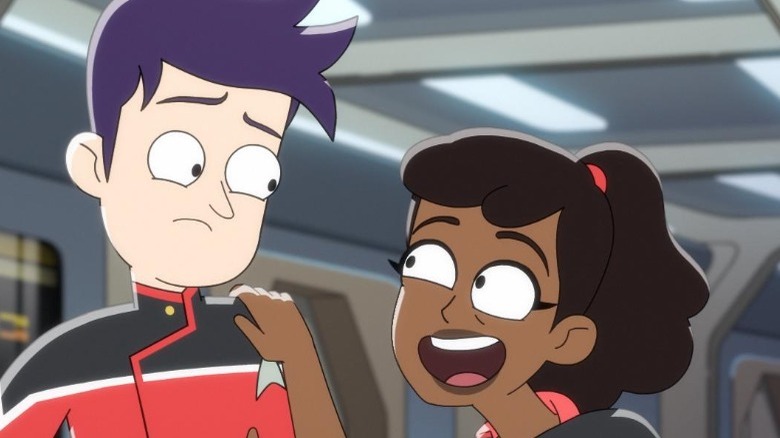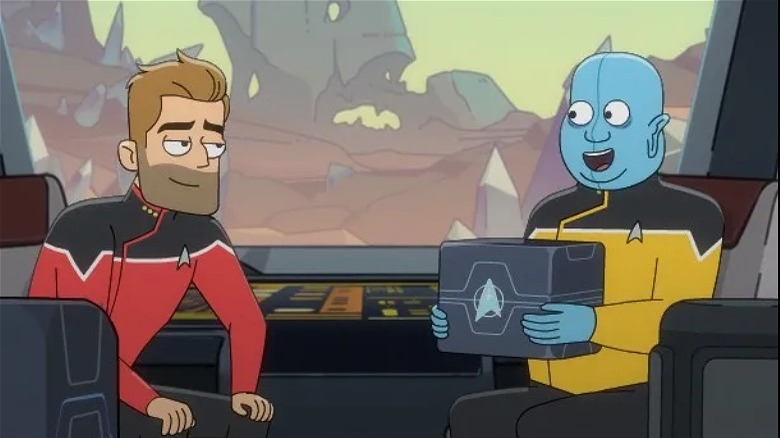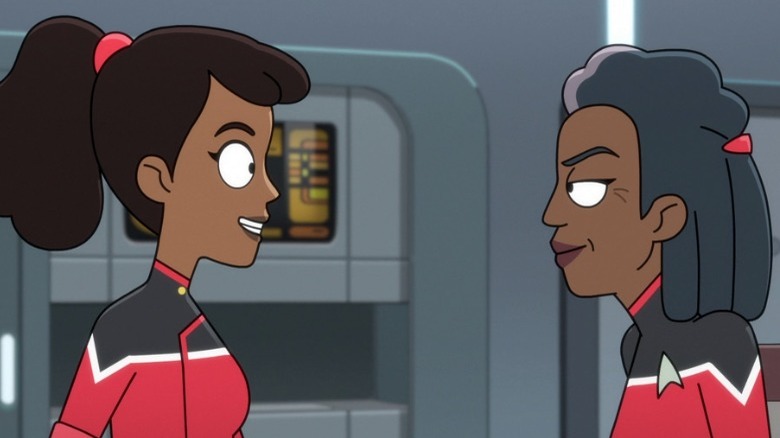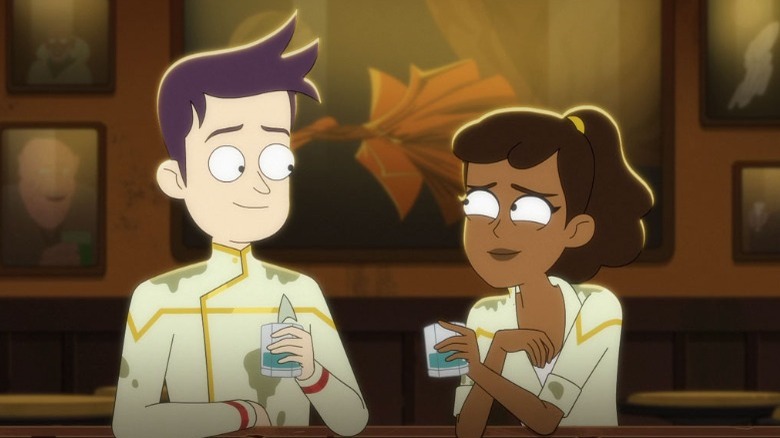14 Reasons Why Star Trek: Lower Decks Is The Best Star Trek Show
"Star Trek: Lower Decks" takes fans to the weirder side of the "Trek" universe. The second series presented in a traditional animated cartoon style (not to disregard the delightful 3D CGI "Prodigy") is as adult as its forefathers, but it's a lot funnier, playing to an audience that's grown up with the franchise. It's also one of the few new spin-offs to push into the future of Starfleet. Set in the late 24th century, the crew of the California class USS Cerritos lives under the shadows of Capts. Picard and Janeway. Sometimes, they're none too happy about it.
With First Officer Jack Ransome at her side, Capt. Carol Freeman is a mother to her crew, but the series isn't about what's going on up on the command deck. Instead, we hang out with the background characters. Freeman's daughter, Beckett Mariner, and the other ensigns on her shift crew do the dirty work the officers don't bother with. That doesn't mean they escape the notice of top-tier visitors like Q and Cmdr. William Riker. This is their story, and honestly, it's some of the best "Trek" of the new era. Here's why.
It's not a joke
"Lower Decks" does retain the thick veneer of a goofy cartoon. It's meant to be funny, and it often is. However, it treats the "Star Trek" canon with real — if amused — seriousness. The Cerritos is a California class starship, named for a real-life city and with loads of thought and detail put into a type of vessel that's typically relegated to the background. In showrunner Mike McMahan's words, they're utility and support, signified by the yellow Engineering paint-job. The Cerritos is part of a greater fleet, and it looks like it.
The crew's uniforms evolve from the geometric design of "The Next Generation," but skip the grey, layered shoulders of the films. While detail junkies may argue whether the Cerritos is up to date or not, the uniform was thoughtfully chosen. It's a riff on an unused 1994 "Generations" design. Visually, this choice reminds us how much this show relies on the best of "Star Trek" to land its jokes.
It tackles some big issues
The first season finale, "No Small Parts," gives Capt. Freeman a platform to call out Starfleet for a long-running issue. "Star Trek" is at its best when exploring strange new worlds, but how are they managing a follow-up? As it turns out, not so great. The often-anthological franchise has a history of one-off visits to new civilizations, dropping a moral lecture, and taking off again. While that's often great television, there's also the chance of unseen consequences when canon keeps moving forward.
Freeman starts off the episode with a big one. Kirk and the Enterprise crew last visited Beta III in 1967's "The Return of the Archons," freeing the populace from an AI named Landru. While Kirk does deploy a team to help the populace, it's not clear if long-term plans were made. Almost 120 years later, Beta III has regressed to worshipping Landru all over again. It sets up an even bigger situation by the end of the episode when a disregarded alien race turns up with a ton of muscle.
The Pakleds return
Lumbering and silly, the Pakleds were also more sinister than they seemed. Introduced in a second season episode of "The Next Generation" titled "Samaritan Snare," the Pakleds use their simplistic but effective cunning to nearly steal Geordi LaForge away from Starfleet. They may not be the wisest race in the galaxy, but they're opportunistic and sticky-fingered. Given a handful of other brief appearances across the franchise from being the rescuers of Data's brother, Lore, to refuse haulers and background aliens on "Deep Space Nine," the Pakleds were mostly ignored.
As Geordi could have reminded everyone, this was a bad idea. Though "Lower Decks" plays up their foolishness and inability to stick to an intricate infiltration plot, the Pakleds are a genuine threat. Their new Clumpship fleet may be Starfleet's junk drawer incarnate, but they pack serious firepower. They're capable of going toe-to-toe with top-of-the-line Starfleet vessels, and the Cerritos is nearly wiped out before Capt. Riker and his USS Titan capital ship arrive to save the day. It's a great reminder that everything matters when building something as sprawling as "Star Trek."
Darmok and Jalad on the ocean
The second season of "Lower Decks" introduces a new security officer to the crew after the untimely but temporary loss of Bajoran security chief Shaxs. Years after Capt. Picard earned the friendship of Captain Dathon in the fifth season "Next Generation episode"Darmok," Kayshon is the first Tamarian to join Starfleet. Dathon and his people speak only in metaphors keyed to the cultural history of their race, a riddle Picard gradually unlocks with the help of the Epic of Gilgamesh.
It's one of the smartest episodes of "Star Trek," and it's a favorite for good reason. Like the Pakleds, the Tamarians haven't featured in the grander tapestry of the franchise ... until now. Starfleet translators have figured out the Tamarian language for the most part, but linguistic goofiness is something new that Kayshon brings to the table. His place as the first Tamarian isn't a joke to anyone. His lapse into strange metaphors isn't a platform for veiled racism, it's just funny adaptations. He's a great addition to a unique cast. Kayshon and Mariner, on the ocean. That means friendship.
We love cats
Both "Lower Decks" and "Prodigy" bring back the cutest denizens of the galaxy. Furry and bipedal with feline features, Cerritos medical officer Dr. T'Ana is a Caitian. She's also pure cat, of the "Don't touch my belly!" variety. She's unable to resist a good box and is always looking more than a little scrungy. The first Caitian we meet in "Star Trek" canon is an operations officer named M'ress in "Star Trek: The Animated Series." Caitians have popped up in the background a few times since but rarely earned the spotlight. That makes T'Ana an extra-special delight.
There are two cat species featured on the Cerritos, and that's a neat thing that live-action can rarely offer. It's a treat to see the Kzinti again, a bigger, buffer species of cat-people with some genetic ties to the Caitians. They're also the only "Star Trek" race not native to the franchise. They were created by Hugo Award-winning author Larry Niven and borrowed, with permission, by Gene Roddenberry. Now one hangs with a clique of wannabe Rikers on the Cerritos. His ancestors would be proud.
A necessary perspective
It used to be that viewing a Starfleet operation from anywhere but the command deck and engineering were the provinces of "very special episodes." Even then, these moments tended to feature the leading crew. Picard's stuck in an elevator with kids, or Ensign Ro is getting the spotlight alongside Worf's security team. However, "Lower Decks" stays with the grunts that do the hard work of keeping a starship running. Sometimes that's power-washing the Jeffries tubes or cleaning up the latest batch of dangerous alien artifacts the command team has left lying around.
The shift in perspective is larger than that. "Lower Decks" is the first spin-off to dig into what it's like for everyone else to live in the shadow of the USS Enterprise and its famous crew. Everyone is rightfully proud of the work the greatest ship in the fleet did, but having such a golden child is sometimes exhausting for "lesser" vessels who do good work but don't get their name in lights over it.
Riker's back!
William Riker is as famed as Jean-Luc Picard, and his actor, Jonathan Frakes, is an accomplished voice artist and jazz devotee. And director. And he wore a Captain America costume a few times. But let's focus on the former stuff. After Riker's term on the Enterprise, he's now a full captain in charge of Starfleet's top-of-the-line capital ship the USS Titan. In perfect Riker style, he zooms in to save the day in "No Small Parts," the Season 1 finale, but he's not done yet.
Season 2 sees Riker hang around for a few episodes as Ensign Boimler, transferred to a position on the Titan, tries to figure out what he wants for himself. Being on the popular ship is as terrifying as it is fun, as Riker is totally unleashed as a captain and howls jazz puns in the middle of any conflict, no matter how tense. It's all too much for Boimler, but it's great stuff for "Next Generation" fans.
Earnest lessons
The jokes come hot and heavy, but the core of classic "Trek" still burns inside these ensigns. Dignity, loyalty, and courage have meaning for the people of Starfleet. In between the gags are the reminders that this is a crew that will fight to the end to back each other up. Many episodes feature at least a subplot in which the ensigns support and learn new things about each other, like Mariner's ad hoc road trip with Tendi turning into less of a girl's night out and becoming more of a lesson about mutual respect.
The show's standout moment may be during "The Spy Humongous," with the somewhat timid Ensign Boimler turning on the in-crowd of redshirts with the realization that although some may command, how it's done is what matters. Boimler throws himself into a conga line of public embarrassment to save his crewmate and friend Tendi. It's what Picard would do. The cool speeches the redshirts cling to are the least important part of being a real hero in Starfleet.
It proves The Orville is right
"The Orville" and "Lower Decks" coexist as ways of humorously exploring the sometimes mundane side of space opera. Like "Galaxy Quest," "The Orville" is almost an honorary member of the "Trek" universe. It does a lot of the same things as "Lower Decks," but in some pretty different ways. Seth MacFarlane's love for "Trek" and science fiction in general always shines through, though, and some of his most Roddenberry-esque stories, like "About A Girl," successfully hit a thoughtful note.
"Lower Decks" is lighter, quicker, and gets to keep the Starfleet serial numbers on all its toys. Comparing them in an attempt to see who lovingly lampoons the franchise better isn't as much fun as realizing they complement each other. Both shows use brash comedy to deflate a franchise that may be spending a little too much time with its darker "nu-Trek" spin-offs. The instant success of "Strange New Worlds" shows that the comedians were right. We love the fun of "Star Trek" and the joy of new discoveries.
Visitors on deck
While every episode of "Lower Decks" is chock full of obscure references for lorehounds to laugh at, it's also casual and new fan-friendly in a way some of the franchise spin-offs forget to be. It helps to know a little bit about "Star Trek" in that the Enterprise is always the coolest ship in the fleet, and a few of its crews are famous in-story and out, but for once, there's no need to consult Spock's sprawling family tree to enjoy what a new "Star Trek" series has on offer.
"Lower Decks" has a self-contained crew, featuring all-new quirks, and each member of the Cerritos family can stand on their own without a lot of franchise backstory. Longtime fans may know what D'Vana Tendi's Orion heritage means, but the show does a great job giving enough information that anyone can get a kick out of meeting her space pirate family in "We'll Always Have Tom Paris."
It's not Rick and Morty in space
We're not here to dunk on "Rick and Morty." With machine-gun dialogue and some smart jokes, it's popular for good reason. Still, it may be easy for a wary "Star Trek" fan to look at "Lower Decks" and fear that it's just the Council of Ricks with a Starfleet veneer. Have no fear. This show blazes its own trail. The animation, composed by the 20-year-old industry veteran studio Titmouse, has a clean and big-eyed style that at first brush resembles its science fiction cousin, but it sticks with a sleeker look for its space battles that always keeps "Trek" canon in mind.
At 22 minutes an episode, time is a valuable commodity. While the rapid-fire dialogue both shows share feels like a similarity, it's born of necessity, not homage. "Lower Decks" slows its pace and finds its groove after the first several episodes, and it's good at knowing when to let its big moments breathe.
The return of the diplomatic mission
In addition to Captain Beckett's call-out regarding checking in on new and old friends, the Cerritos is part of a vast fleet of support ships that do the mundane work the cool kids are too hip for: talkative old diplomatic missions. The Cerritos isn't rated for first contact work, but sometimes it's still pretty close to the front of the line when dealing with new worlds. While "Strange New Worlds" is picking up the slack on this classic "Trek" tradition, it's still fun to sit back and watch Captain Freeman talk to the big view screen on the command deck.
It may not sound fresh and hip, but there's something refreshing about people at least trying to talk through their differences. The crew of the Cerritos doesn't always succeed, and when they do, it's a tough ride. But let's face it, the Enterprise crew cleared a few hurdles themselves. It's a brilliant reminder that Starfleet has always been about the diplomatic mission first, learning more about each other and ourselves.
Family matters
Family ties are a rich source of drama in nearly any series. With multiple entries focusing on Spock's ever-increasing number of relatives, and "Picard" recently exploring the painful cycle of emotional trauma, "Star Trek" is no different. Nevertheless, the mother-daughter relationship between Captain Carol Freeman and Beckett Mariner is refreshing stuff. Season 1 sees the pair trying to keep their blood tie a secret from the rest of the Cerritos, even while Captain Freeman is exhausted with Mariner's hijinks.
It's a neat twist on the dynamic between Beverly and Wesley Crusher. Like Wes, Mariner is adept at everything from combat tactics to alien languages, but she is hard-pressed to give a rip, much less try to secure herself an impressive place on the command deck. Season 2 gives Mariner and her mom a reason to explore their relationship, recognizing that their differences make them both stronger, even when they drive each other up the wall.
Lower Decks loves Star Trek, and it shows
Although it's not above prank-calling some of the grimmest antagonists "Star Trek" has to offer, the love "Lower Decks" and its creator, Mike McMahan, have for the franchise always shines through. McMahan is the kind of hardcore fan that consults Okudagrams and starship blueprints to ensure canon accuracy. It's that dedication that brings to life some of the most obscure Easter eggs and cameos that even dedicated lore junkies might miss at first glance.
Nearly every episode contains a blink-and-you'll-miss-it call-back to the franchise forefathers. With a dive bar that boasts a connection to Kirk and Spock, "An Embarrassment of Dooplers" is a treasure trove of hidden trivia. On its walls are at least 19 faded paintings, and all of them are homages to moments like Sisko's Bajoran lightship or the Horta. "Kayshon, His Eyes Open" is another delight, with a collector ship containing silly treats like Spock's enormous skeleton. They're the sort of gags meant to delight, and it goes to show that a little gentle teasing can be good for the soul. "Star Trek: Lower Decks" wears its love on its sleeve, and that uplifts the entire franchise, reminding us why "Star Trek" is so special.
